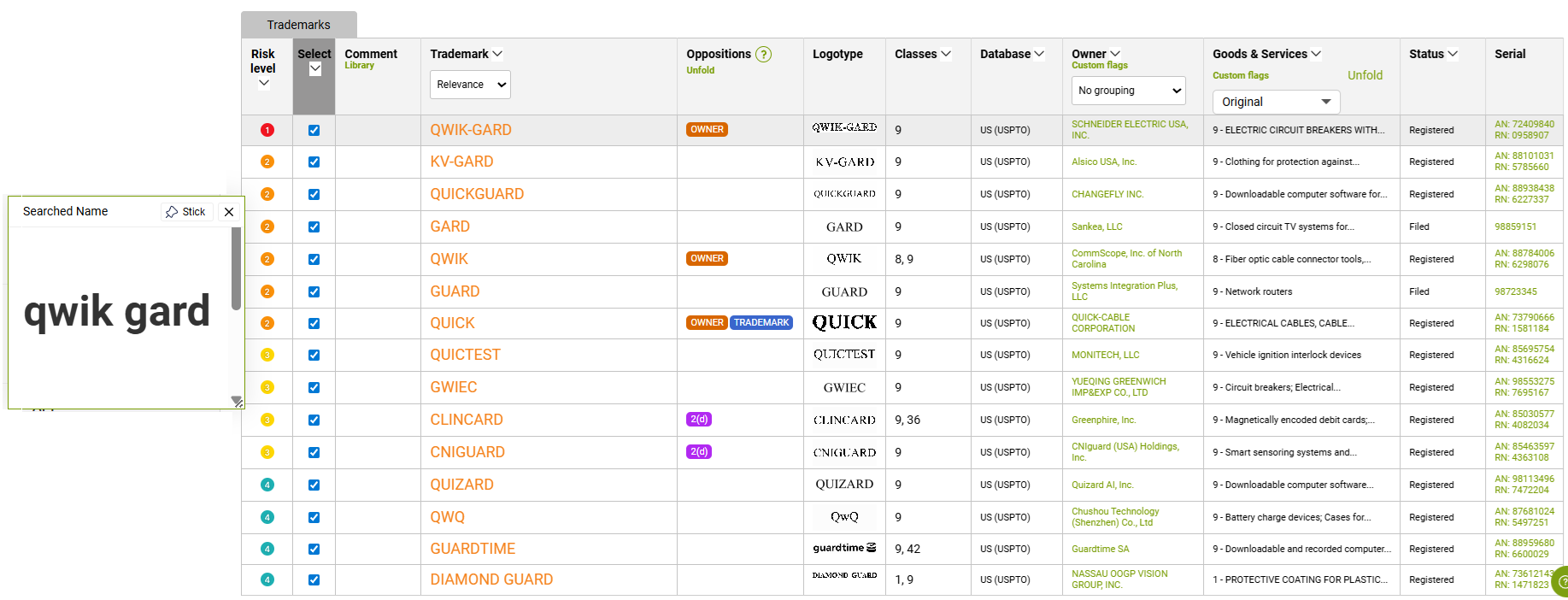Markify algorithms (Word & Image) are built using predictive AI while being trained on real legal cases (opposition and 2d citation data, more than 1.5 million conflicting pairs analyzed).
Markify uses statistical approach towards ranking potential results, based on how often analogical cases have led to a conflict.
Our wordmark search algorithm covers all the usual search strategies applied in manual searching:
identical results
orthographic similarity and misspellings
prefix/infix/suffix variations
vowel & consonant similarity
plurals, stemming, abbreviations, etc.
The algorithm also analyzes descriptiveness/usage frequency depending on the territory of the search. This explains that the ranking for the same term searched in different databases is based on whether that is a dictionary word in a specific country.
Results are ranked into Risk levels to help focus the attention on the most relevant hits:
RL1 - Risk Level 1 - Very high risk
RL2 - Risk Level 2 - High risk
RL3 - Risk Level 3 - Medium risk
RL4 - Risk Level 4 - Low risk
When the search or watch reports are produced, each potential result is analyzed individually and obtains a certain score that determines its position within the search report, as well as the assigned risk level.
Because the ranking is driven by multiple statistical parameters, it is not possible to define strict, rule-based thresholds for each Risk Level, but there are some general tendencies that you can see:
Risk Level 1 covers exact matches only (including normalization of special characters)
Risk Level 2 covers the most similar results, starting with very close variations, such as plurals/singulars, duplicated or missing letters or other minimal transformations.
Further in RL2 and the next risk levels (RL3 and RL4), you will have a gradual display of less similar matches, such as orthographic and phonetic variants, different spellings or typos, marks that contain parts or components of the term (if it can be split/decompounded), including variations of those parts.

(Please only treat the screenshot above as an illustrative sampling of search results, this is not a full set of potential matches)
The four "Risk levels" indicate statistically where you will find potential conflicts.
Level 1 - Very high risk. Of all conflicts, 20% have these types of similarities.
Level 2 - High risk. Of all conflicts in Europe or the US, 40% have these types of similarities.
Level 3 - Medium risk. Of all conflicts in Europe or the US, 25% have these types of similarities.
Level 4 - Low risk. Of all conflicts in Europe or the US, 15% have these types of similarities
As our AI options do not provide a very clear "mathematical" calculation on the number of edits that are included into each Risk Level or Language, or a very detailed explanation of the strategy. For those who prefer to have more control over the search options, the Boolean search mode is a good complement, since it allows to precisely define the variations allowed within the search strategy (see the dedicated article on Presets option here)
The Markify AI-powered Image algorithm combines advanced image-recognition technologies with trademark knowledge, as it is trained on the real examples of the conflicts (opposition cases and 2d citations).
Unlike generic image search tools, it doesn’t just recognize visual similarities: it brings the technology into a trademark environment, making it a powerful tool for identifying potential conflict.
You will see the image search algorithm producing results similar by shape, colour, and overall visuality. Please note that it does not do text recognition but rather concentrates on fonts and shapes if there is any script on the image, so verbal elements are recommended to be searched (or watched) separately - pleasee our detailed guidelines on that at the link.
(Please only treat the screenshot above as an illustrative sampling of search results, this is not a full set of potential matches)
Markify’s industrial design search uses the same visual AI foundation as image mark search, extended with specific training on design conflict examples.
Risk levels (RL1–RL4) are also applied here.
When multiple design images are uploaded, the highest similarity score among any pair determines the final risk level — ensuring that even one strong match is highlighted.

(Please only treat the screenshot above as an illustrative sampling of search results, this is not a full set of potential matches)
Benefits of using the AI-driven search:
Efficiency gain, as algorithmic searches significantly reduce the time required by defining the strategy
Manual effort is minimized, allowing users to focus on decision-making rather than exhaustive exploration
